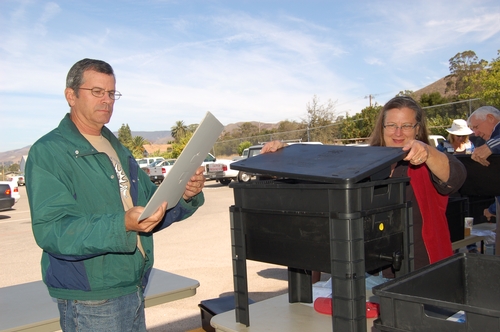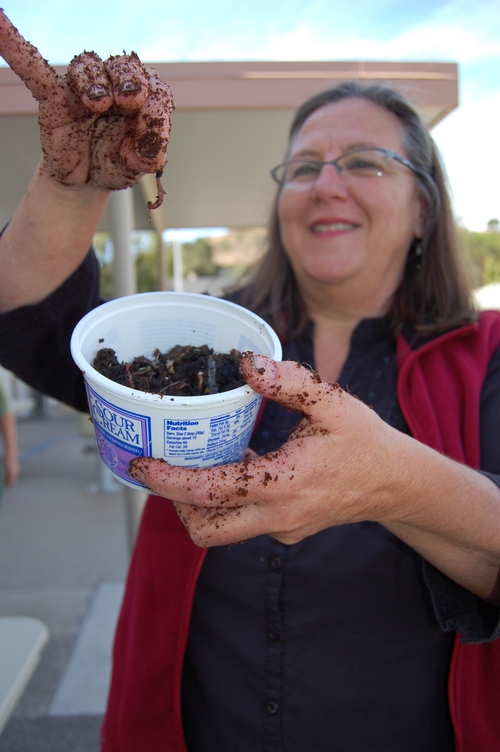The worm bins are $120 and must be paid for online or by check. Please make checks payable to "UC REGENTS".
Our next class is scheduled for September 8, 2012.
You can place your order by clicking on this link or reserve a spot if you would like to sit in:
Below is a little article by Lee Oliphant.. Thank you Lee!
Worm Composting - Composting on a Small Scale
By Lee Oliphant, Ed.D., Master Gardener
Traditional composting is not for everyone. Some folks just don’t have the space for composting bins but would love to have some of the “black gold” plant food that composting provides. If you want to try composting on a smaller, more concentrated level, worm composting (or vermicomposting) might be the answer for providing food for your plants while recycling kitchen scraps and newspaper or shredded office paper. The resultant castings provided by worm composting is a nutrient rich additive to soil. The leachate caught from the box can also be diluted and used to water ornamental plants.
Worm composting requires a shady, cool place for your worms to live. You will need only a few things to begin worm composting: a worm bin, newspaper bedding, kitchen scraps and, of course, your little “Red Wigglers” (Eisenia foetida).
Your Worm Bin
Commercial worm bins are available or you may begin your worm composting you might want to purchase a simple 5 to 10 gallon plastic tub with a lid that snaps shut. Worms like darkness, so an opaque bin is best. Drill 1/4 inch holes around the bin about 4 inches down from the top and 2 to 4 inches apart.
Worms thrive in temperatures between 50 and 75 degrees. Options for bin locations are the garage, basement, a shady deck or area in your garden, or in a garden shed. In the winter, make sure that the box is sheltered from the rain. The worms require oxygen and will easily drown!

Worm Bedding
In their natural habitat, “Red Wigglers” live in piles of fallen leaves above the soil surface. The best bedding in your bin is shredded paper such as uncolored newsprint or cardboard. Prepare your worm bedding by wetting the paper and wringing it or drain it until is like a wrung-out sponge. Separate the damp strips.

Worm Food
A pound of red worms need about a pound of scraps each week. They eat just about any part of fruits and vegetables, coffee grounds and filters, tea bags and watermelon rinds. To begin, layer about a pound of scraps over the bedding. Do not put meat, oils, cat or dog feces, or dairy products, citrus peels or bread that contains yeast in your bin! While worms can survive longer without food, they enjoy a weekly feeding.
The Worm Crew
”Red Wigglers” Eisenia foetida (not to be confused with earthworms) can be purchased at garden centers, bait shops or from suppliers on the Internet. You will need less than a half-pound of worms to begin your worm composting. Worms need to be separated from their casting about twice a year. One method for separation is to push the decomposed material to one side of the bin and remake the worms’ bed with paper and kitchen scraps. Worms will eventually migrate to the freshly filled side of the bin leaving you with fresh compost.
Another method for those of us who can’t wait for the wigglers to meander to “greener” pastures so that castings can be harvested is to expose the open bin to bright light or sunlight. The worms will dive for darker quarters. After a few minutes, remove the top inch (sans worms) and repeat.

Your Payoff
Worm compost is ready to use when all vegetation has been digested. It is very concentrated. You can sprinkle and dig it into freshly cultivated soil or mix one part worm compost to four parts potting mix. .
There are many informational resources for worm composting available. California Department of Resources Recycling and Recovery has an excellent resource page. “Worms Eat My Garbage” by Mary Appelhoff is a book that provides extensive coverage on the subject. Her Web site is wormwoman.com.
Having trouble with your worm bin? Contact the Master Gardeners! mgsanluisobispo@ucdavis.edu
Click HERE to read more articles about Worm Composting.
Did you find some weird larvae in your worm bin?
Click here to see the image.
Soldier Fly Larvae seems to appear in my worm box throughout the year. Once you recover from their ugliness, you will find that they are excellent composters and the flies are never even seen!
Attached Images:
